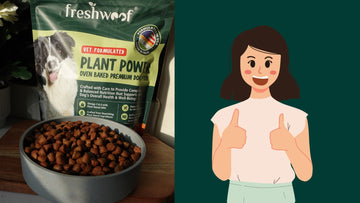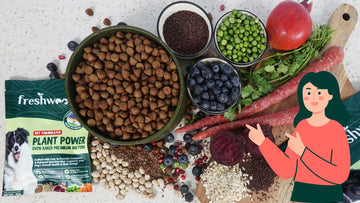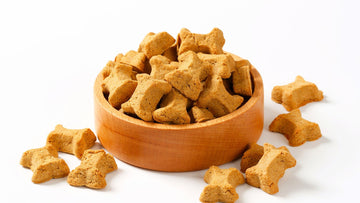The raw meat diet has gained a lot of popularity recently because of the assumption that it is more natural than any other available options. Magazines, social media, and advertisers have been depicting dogs as wolves while using the terms such as “ancestral”, “biologically appropriate”, etc. But is raw meat diet good for our pets? Looking at the facts, raw animal meat has risks. According to the FDA, Centers for Disease Control (CDC), American Veterinary Medical Association, British Small Animal Veterinary Association, Canadian Veterinary Medical Association, World Small Animal Veterinary Association, and a host of other organizations, raw meat pet food is the diet most likely to introduce disease-causing bacteria into our pets and our homes.
One study found that in a group of two hundred therapy dogs, the incidence of Salmonella in raw animal meat-fed dogs was 0.61 cases/dog per year, compared with 0.08 cases/dog per year in dogs that were not fed raw meat (Lefebvre S. L., et al. “Evaluation of the Risks of Shedding Salmonellae and Other Potential Pathogens by Therapy Dogs Fed Raw Diets in Ontario and Alberta.” Zoonoses Public Health), certainly risks with raw animal diet is higher.
A 2019 study tested raw meat dog foods from 10 manufacturers and found that 100% contained bacteria species indicating fecal contamination and poor hygiene standards. Some of the commonly-known pathogens that can be present in meat include Salmonella, E. coli, and Campylobacter. Other pathogens that may contaminate raw meat include Toxoplasma Gondii (the toxoplasmosis), Cryptosporidium, Echinococcus, Clostridium, Neospora, and Sarcocystis. The same applies to raw meat fed to pets. Fortune, a global media organization reported an increase in raw dog food recalls (called back) due to contamination (https://fortune.com/2018/02/16/pet-food-recalls/ ) and an FDA study found significantly higher levels of salmonella and E .coli bacteria in raw pet food samples than in other types of pet food (FDA. “Get Facts: Raw Pet Food Diets Can Be Dangerous to You and Your Pet.” February 22, 2018. <https://www.fda.gov/animal-veterinary/animal-health-literacy/get-facts-raw-pet-food-diets-can-be-dangerous-you-and-your-pet.
If raw food isn’t adequately treated to eliminate contaminants, you could be feeding your pet potentially harmful pathogens that could cause illness in your pets and even expose other family members including yourself to these harmful bacteria. Contaminated raw animal meats pose a serious health risk to pet owners who handle the foods, packaging, and wastes. Secondary transmission is especially dangerous to children, older persons, and immunocompromised individuals (LeJeune, Jeffrey T., and Dale D. Hancock. “Public Health Concerns Associated with Feeding Raw Meat Diets to Dogs.” Journal of the American Veterinary Medical Association (November 1, 2001) 219(9): 1222–1225.)
The assumption that dogs are prehistoric predators lusting to kill and eat other animals persist among pet parents and this assumption is often used by marketers of high-meat or raw diets. According to them what a dog ate millions of years ago is the best diet; this is certainly not true for modern dogs. Modern animal meats potentially contain many contaminants, toxins, pathogenic bacteria, and added antibiotics and hormones. They're not very “natural.” The “raw meat” fed to a dog today is far more different from a prey a wolf killed tens of thousands of years ago or even hundreds. In the “real wild”, a wolf would consume their kill immediately. This means the fresh meat would have little chance to become contaminated by pathogenic bacteria. There would also be no added antibiotics, hormones, or growth-boosting substance injected into the animal.
Also, it is clear from genetic science that our four-legged friends have undergone the process of evolution just like us and the modern dogs are no longer strict carnivores like their ancestors. Dogs and humans have been partners in the journey of evolution, according to a study. Researchers from the University of Chicago and several international institutions found that several groups of genes in humans and dogs—including those related to diet and digestion, and neurological processes have been evolving in parallel for thousands of years, this parallel evolution took place maybe be due to shared environment of humans and dogs, wrote the authors in a study published May 14 in the journal Nature Communications. Those changes could be due to a dramatic change in the proportion of animal versus plant-based foods that occurred in both at around the same time, the researchers said (https://www.livescience.com/31997-dogs-and-humans-evolved-together.html , https://www.nationalgeographic.com/news/2013/5/130514-dogs-domestication-humans-genome-science/).
Our domestic dogs no longer hunt for food, nor are they wild. Thousand years of co-dependency and parallel evolution have made dogs more similar to us and different from their ancestors. Dogs have adapted to a variety of diets, they can thrive on a meat-based diet, a raw diet, and also on a plant-based diet. But our dogs rely on us for their life decisions. It is our responsibility to choose the right and the best diet for our pets, a diet with maximum benefits and the least possible or no disadvantages. It’s time to dig into science, go with the facts and make the best decisions for our beloved pets.





